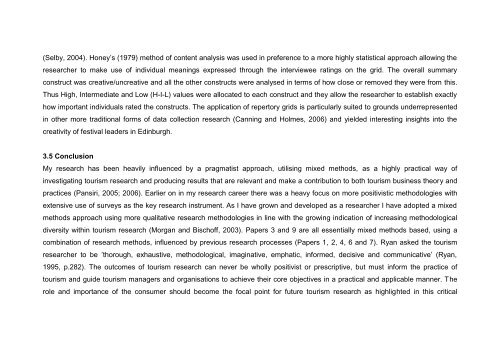The Role of Niche Tourism Products in Destination - Repository ...
The Role of Niche Tourism Products in Destination - Repository ...
The Role of Niche Tourism Products in Destination - Repository ...
Create successful ePaper yourself
Turn your PDF publications into a flip-book with our unique Google optimized e-Paper software.
(Selby, 2004). Honey’s (1979) method <strong>of</strong> content analysis was used <strong>in</strong> preference to a more highly statistical approach allow<strong>in</strong>g the<br />
researcher to make use <strong>of</strong> <strong>in</strong>dividual mean<strong>in</strong>gs expressed through the <strong>in</strong>terviewee rat<strong>in</strong>gs on the grid. <strong>The</strong> overall summary<br />
construct was creative/uncreative and all the other constructs were analysed <strong>in</strong> terms <strong>of</strong> how close or removed they were from this.<br />
Thus High, Intermediate and Low (H-I-L) values were allocated to each construct and they allow the researcher to establish exactly<br />
how important <strong>in</strong>dividuals rated the constructs. <strong>The</strong> application <strong>of</strong> repertory grids is particularly suited to grounds underrepresented<br />
<strong>in</strong> other more traditional forms <strong>of</strong> data collection research (Cann<strong>in</strong>g and Holmes, 2006) and yielded <strong>in</strong>terest<strong>in</strong>g <strong>in</strong>sights <strong>in</strong>to the<br />
creativity <strong>of</strong> festival leaders <strong>in</strong> Ed<strong>in</strong>burgh.<br />
3.5 Conclusion<br />
My research has been heavily <strong>in</strong>fluenced by a pragmatist approach, utilis<strong>in</strong>g mixed methods, as a highly practical way <strong>of</strong><br />
<strong>in</strong>vestigat<strong>in</strong>g tourism research and produc<strong>in</strong>g results that are relevant and make a contribution to both tourism bus<strong>in</strong>ess theory and<br />
practices (Pansiri, 2005; 2006). Earlier on <strong>in</strong> my research career there was a heavy focus on more positivistic methodologies with<br />
extensive use <strong>of</strong> surveys as the key research <strong>in</strong>strument. As I have grown and developed as a researcher I have adopted a mixed<br />
methods approach us<strong>in</strong>g more qualitative research methodologies <strong>in</strong> l<strong>in</strong>e with the grow<strong>in</strong>g <strong>in</strong>dication <strong>of</strong> <strong>in</strong>creas<strong>in</strong>g methodological<br />
diversity with<strong>in</strong> tourism research (Morgan and Bisch<strong>of</strong>f, 2003). Papers 3 and 9 are all essentially mixed methods based, us<strong>in</strong>g a<br />
comb<strong>in</strong>ation <strong>of</strong> research methods, <strong>in</strong>fluenced by previous research processes (Papers 1, 2, 4, 6 and 7). Ryan asked the tourism<br />
researcher to be ’thorough, exhaustive, methodological, imag<strong>in</strong>ative, emphatic, <strong>in</strong>formed, decisive and communicative’ (Ryan,<br />
1995, p.282). <strong>The</strong> outcomes <strong>of</strong> tourism research can never be wholly positivist or prescriptive, but must <strong>in</strong>form the practice <strong>of</strong><br />
tourism and guide tourism managers and organisations to achieve their core objectives <strong>in</strong> a practical and applicable manner. <strong>The</strong><br />
role and importance <strong>of</strong> the consumer should become the focal po<strong>in</strong>t for future tourism research as highlighted <strong>in</strong> this critical
















